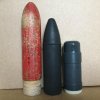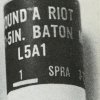The RSAF Enfield built baton round guns utilising 1.5” No.4 Mk.1* signal pistols as the base weapon to which an extended barrel and steel stock was attached.
The L48 series was smoothbore. I believe there was an L48A1 and an L48A2 variant.
The National Army Museum website shows the experimental XL48E1.
The L67 series was rifled. Introduced in Northern Ireland from October 1974 with the L5A3 baton round. I believe there were L67A1, L67A2, L67A3, and L67A4 variants.
The L67A4 was deployed with the L5A7 baton round as recently as Operation Herrick in Afghanistan. (Source online DOMILL report from 2008)
There is a lot of misinformation on the internet about these guns, so does anyone have reliable information that states what the differences were between the different variants?
PM me if you don’t want to post on here. Thank you.
The L48 series was smoothbore. I believe there was an L48A1 and an L48A2 variant.
The National Army Museum website shows the experimental XL48E1.
The L67 series was rifled. Introduced in Northern Ireland from October 1974 with the L5A3 baton round. I believe there were L67A1, L67A2, L67A3, and L67A4 variants.
The L67A4 was deployed with the L5A7 baton round as recently as Operation Herrick in Afghanistan. (Source online DOMILL report from 2008)
There is a lot of misinformation on the internet about these guns, so does anyone have reliable information that states what the differences were between the different variants?
PM me if you don’t want to post on here. Thank you.























